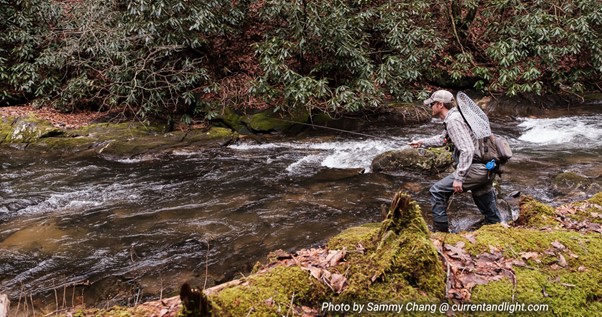- Empty cart.
- Continue Shopping
Fly Fishing the Mono Rig: It’s Casting, Not Lobbing

NYMPHING | TACTICS | THE MONO RIG
Most of my weekday mornings start somewhere in a gravel or dirt space that’s large enough for a couple of cars. Surrounded by hemlocks, ferns and flowing water, it’s a privilege to guide the wild trout rivers that I’ve loved and fished for much of my life. Most anglers come to me because they want to learn something. These are wild waters, public creeks with no setups, harboring trout that respond only to quality presentations and a persistent approach. So my guests are ready for that. And more often than not, they are interested in refining tight line tactics — Mono Rig stuff.
I love teaching dry fly fishing too. Watching friends refine the elegant manipulations of fly line is rewarding. In a few hours they learn to use the last hitch of the wrist. It’s deliberately emphasized to send a Parachute Ant into a six-inch pocket with an extra bit of slack tippet, just upstream and into the neighboring current. Fish on. Smiles all around.
Having the opportunity to guide every day and teach these tactics has made me a better communicator of the ideas. People come with all different skill levels, with different biases, preferences and desires. And I find myself emphasizing many of the same points over and over, searching daily for the words and sentences that might connect the concepts with the fly fisher who accompanies me. Long ago I realized that it’s much easier to show some things rather than speak them. And there’s one major point about the Mono Rig that’s much better seen than heard: Good angling with a Mono Rig comes from casting, not lobbing.
READ: Troutbitten | Fly fishing the Mono Rig — Thicker leaders cast more like fly line
[ILFF has consent to re-publish this content.]
Watch This:
As my guests and I gear up in that gravel lot, tying boot laces, checking the material remaining on tippet spools and replacing empty slots in fly boxes, I often grab a fly rod and cast the Mono Rig.
With no fly attached, and with no fly line off the spool or out of the guides, I cast about twenty feet of butt section, sighter and tippet. And I emphasize the following: back-stop-forward-stop, accelerate between two points and stop crisply. These are standard fly casting principles. And if you really want to use the Mono Rig, if you want to do anything more than tight line a pair of heavy-ish nymphs, then good casting principles are more important than ever.
My new friends easily notice the difference when I show them a crisp, clean casting stroke vs a slow one (without the speed or hard stops.) When cast properly, the Mono Rig easily shoots to the target. Loops build and unfold exactly like the loops we throw in a fly line. That’s where accuracy originates. It’s where contact and control of the fly begins.
I show them how effortless, how compact, a good clean casting stroke is. And they watch the Mono Rig easily achieve whatever targets I find next to our parked vehicles and hemlocks. With no fly or fly line, the Mono Rig shoots to the target with loops identical to the ones we’re used to seeing while casting fly line. And this is a result of its design. The butt section is thick enough and stiff enough to perform like a fly line, yet it weighs a quarter as much and sags far less. The sighter section is built not just for visibility, but for turnover. And even the tippet section is adapted for the same goals. All of this matters most when you ask the Mono Rig to do more — when you cast small yarn indys mounted below the sighter, go tight-line dry dropper or throw a pair of tiny nymphs.
Ironically, it takes refined and excellent fly casting skills to cast a Mono Rig. And I see the surprise on my friends’ faces when they watch the loops unfold, and the Mono Rig sails straight to the target.
READ: Troutbitten | What is Euro Nymphing? And What is the Mono Rig?
READ: Troutbitten | Polarized Sunglasses for Fly Fishers — Why, When and What Kind
Wrong Way
After casting those tight loops on a Mono Rig, then I do it the wrong way. I remove the speed and the crisp stops from the cast, and we watch what happens to the leader. Inevitably, it falls ahead of the rod tip in a pile. So I cast again and reach far out with my arm on the forward cast, because surely that will get the leader out further, right? But no, it makes things worse.
So we watch for the loops again. We watch what happens to a Mono Rig that’s cast without crisp acceleration and hard stops. The resulting wide and open loops have no energy. It’s lobbing, not casting. And that can work (to a point) with enough weight at the end of the line. But try going tight line to a yarn indy or dry dropper. Try using ultralight flies. The rig will fail without enough power in the cast. Furthermore, try casting under the next tree limb without solid, tight casting loops in the Mono Rig. Absent the speed to turn over the leader with direction and authority, you’ll be into the limb every time.
Speed and power, crisp stops and a compact delivery equal accuracy and control of the Mono Rig. This is casting, not lobbing.
Fish hard, friends.
** Find all Troutbitten articles about the Mono Rig here **
Enjoy the day
Domenick Swentosky
T R O U T B I T T E N
domenick@troutbitten.com





